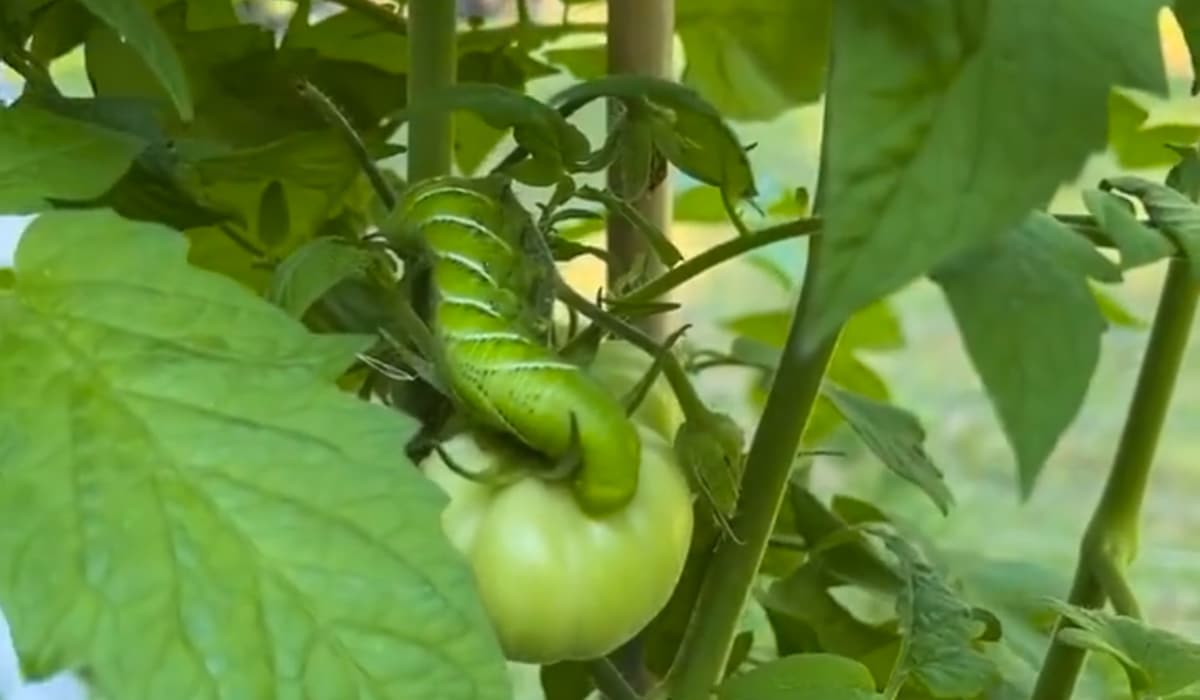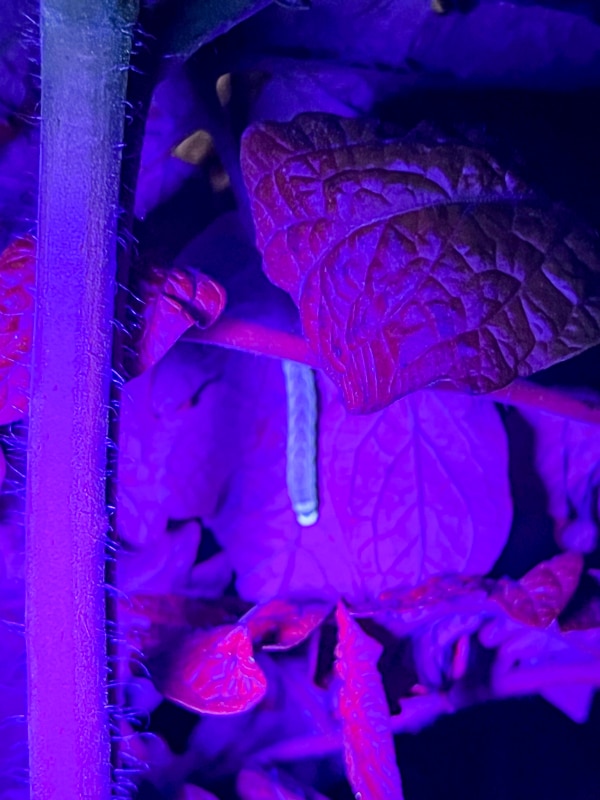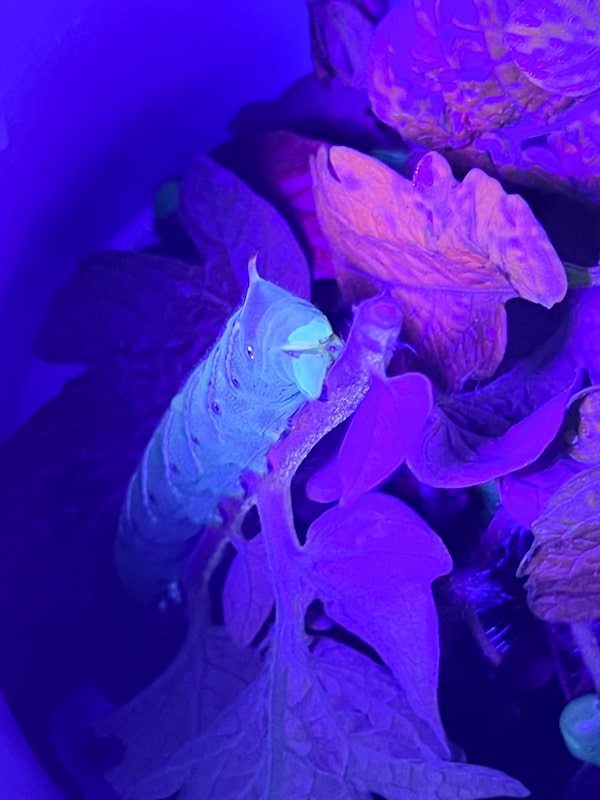I’m not much for nighttime gardening, preferring to spend such hours sitting on the deck watching the fireflies, but last week you would have found me in the vegetable garden peering under leaves with a blacklight. I was on the hunt for an enemy I’ve not done battle with before: tomato hornworm.
Just a few days earlier I’d been tidying up the vegetable garden after a week away (and if you’ve ever left your vegetable garden for a week in summer you know that it goes rogue quickly) and I noticed some bare tomato stems at the top of one of the 18 or so tomatoes I’m growing. My first thought was that it resembled hornworm damage.
Two days later, I was tying in my tomatoes (I love the Florida weave method but you have to stay on top of keeping those tomatoes in check) and right in front of me was the culprit: fat, 4 inches long and the exact color of tomato foliage. It was my first run-in with this horned creature in more than two decades of gardening.

Hornworms are desperately hungry and will quickly decimate tomatoes as well as peppers, potatoes, eggplant and other members of the nightshade family, so quick action and a thorough search is required when a gardener notices the telltale signs—branches stripped of leaves and large bits of frass (such a nice word for insect excrement). By the way, tobacco hornworms are close cousins and are happy to go for your Nicotiana.
HOW TO FIND HORNWORMS
Finding hornworms is not easy because they come with excellent camouflage in the form of their green skin in the exact shade of tomato foliage.
And that’s where my nighttime hunt came into play. Tomato hornworms glow under black light, so a thorough look at the tomato plants can yield a much bigger crop of hornworms than you might expect. I was expecting to find one, maybe two more hornworms, but instead I found eight, ranging in size from about an inch to more than 3 inches.

This is right about the time you will find out how squeamish you are. Few things in the garden elicit a gag reflex more than a hornworm, so while some gardeners won’t have an issue plucking that fat worm with its many suction cup feet (do avoid that horn though), I’m not one of them. Geared up with gloves, hand pruners, a bucket and a glass of wine (for me, not the hornworms), I just cut the branch the worms were attached to and dropped them in the bucket.

WHAT TO DO WITH THEM
Hornworms become beautiful hawkmoths, which are helpful pollinators. Some gardeners plant sacrificial tomato plants to rehome hornworms on so they can fulfill their destiny. Others report that their chickens consider hornworms a particularly delectable treat. Whatever you choose to do with them, just make sure they don’t get back on your plants.
Occasionally you’ll find a hornworm with what looks like grains of rice sticking out of it, and here’s where the tale of the hornworm gets even more gory. These are the larvae of a parasitic wasp and they will eat the hornworm alive. Although you should still remove afflicted hornworms from plants, allow them to live so more of the beneficial parasitic wasps hatch.
Are you horrified yet? Well that makes two of us. I recommend gloves. And wine.
Want to see nighttime hornworm hunting in action? Check out the video below.


9 Responses
NO GLOVES! TONGS are the way to go! Still a bit hard to get off, and I still say “ew! GROSS!”, but better than yer fingers!
I DO 100% agree with the wine though! 😉
I have found about 20 of them on an ornamental willow. They had completely stripped it. I got goosebumps when I tried to pick them off(with gloves). Dropped them and stamped on them. Then I was dismayed to find that wasps were eating the bodies! UGH!!!
Their poop is the way I typically find them. Scan your leaves for chunks of poop, then look up! I also do the “Cut the whol leaf off” method and let the birds find them.
I had no idea about hte blacklight though! Sounds fun and creepy.
I remember my grandma giving my neice something she picked up at a garage sale. Her brother was sad because he didn’t get anything. I let him know grandma was still looking for something special for him. I had found a tomato hornworm and put it in a container. When he stopped by the next day, I gave him the hornworm. He thought it was the coolest present! That was 14 years ago and that was the only time I ever experienced the hornworm. What a memory
Several years ago, I dealt with my first tomato hornworm. I wore garden gloves, but I didn’t know how thoroughly disgusting they were until I tried to pull it from the branch. I could feel it’s grotesque body writhing while I tried to pull it from the branch. Normally, I can be calm under pressure, but I let out a bloodcurdling scream. It must have been terrifying because my four-year-old began crying instantly. If I ever encounter another one, I will take your advice and simply cut off the branch. The more distance between the hornworm and me, the better.
I’m fortunate to have Braconid wasps, lady beetles, green lacewings and blue birds to monitor my garden and take care of those pesky ones. They have never been a problem.
I’m sorry you had to deal with hornworms but I loved your humorous take on the situation! I’ll admit to smashing squash bugs and drowning Japanese beetles with glee, but I would definitely default to your branch-cutting method with hornworms. Cheers to nighttime garden raids!
I’m smashing the “like” button.
I constantly had problems with hornworms decimating ALL my tomato plants until one year I planted basil in amongst the tomatoes. Viola’, no worms. Well, who amongst us doesn’t love the combination of tomato-basil?? Well the worms don’t, so bonus for me. I will agree that though they are yucky to look at, I’ll take butterflies any day to beetles or Fire Ants (oh these pests are ruthless and their bite is worse than a bee sting).